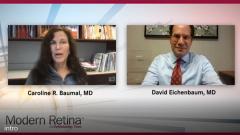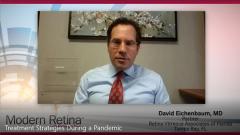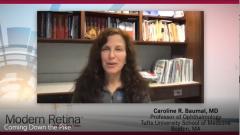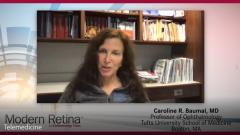
Treatment Burden
Episodes in this series

David Eichenbaum, MD: Now we’re going to discuss some current treatment options and treatment burden. What would you say, Caroline, on average, your average wet AMD patient, your little old lady or little old man who’s 75 years old, comes in 20/63, how many intravitreal injections do you perform per year per eye on this very average patient?
Caroline R. Baumal, MD: I would say the average patient probably has about 8 injections during the first year of treatment. I typically start off treating patients every 4 weeks until the lesion is dry. Now, of course, that can change. There's so many patient factors that go into that — how often the patient can come, the patient's response — but I do typically like to treat them aggressively to get that lesion dry.
Every four weeks just like the studies and making sure that they have an adequate response. Then after that I will slowly start to extend the patient. I'll try to extend them to 8 weeks and gradually to 3 months, and then it depends on patient factors. If the patient's monocular, if that's the patient’s eye that they count on for driving, sometimes I'll continue to inject them every 3 months. That's really the time when the patient's reaction and all of these personal things come into play. That's part of what we can't always capture in the clinical study. I'd say a patient probably has about 8 injections a year in the beginning, and maybe it'll go down to 6 injections the second year.
Then I’ll typically try to continue to follow up these patients, and I'm surprised how often the other eye then develops neovascular AMD. Then that comes into the mix, and then we have this whole issue about whether patients want to have bilateral injection. Initially, I didn't do that many bilateral injections because my patients seemed to be a little bit fearful about it. They didn't think they'd be able to see to function, so now what I'll do is I'll kind of gradually get them into that. Most of my patients with bilateral issues have bilateral injections now.
Dr. Eichenbaum: Let's say that there’s not an access issue, that your average patient could be treated with any of the available anti-angiogenic agents. Which one do you go to typically? What’s your typical agent for dosing in that situation? Where do you go? Where do you reach for, or do you reach, or do you just reach for whatever’s in the cabinet and start with that?
Dr. Baumal: I typically start with one of the FDA approved agents, that's my typical go-to, either ranibizumab or aflibercept. I really like the prefilled syringe. I think that in many of the offices that I go to it takes an extra step out of prep to have the prefilled syringe. The ranibizumab prefilled syringe has been available for a few years, so that made things easy just to get it, put the top on, but now we have aflibercept prefilled syringe which is also a great product. These are my two go-to agents. There are different things that make me decide one medication or another, or sometimes patients have a preference as to which they would like as well. There is also the newer agent, brolucizumab, that's also available for use.
Dr. Eichenbaum: Both of us have experience with brolucizumab. I have a couple of treatment-naive patients I’ve used it on. I have a lot more treatment-experienced patients that I have used it on. I’d agree, my pattern’s very similar to yours. I typically go for a prefilled syringe, FDA-approved product, as my product of choice barring access issues. The question is how do we balance the potential improved efficacy of brolucizumab with some of the safety issues that we've encountered?
Frankly, I've probably used less or ceased my usage for the time being in treatment-naïve patients. There was a patient today that I saw though, who was switched from Eylea to brolucizumab. They saw one of my partners who switched him back to Eylea (aflibercept) for safety concerns, and he came back to me today, and he missed his Beovu. He said he was seeing better, and his anatomy was somewhat better on Beovu. I switched him back. We had a discussion about intraocular inflammation.
We talked about what my partner and he discussed, and I think you have to put these things into context. It's very, very important to not throw the baby out with the bath water as we see new agents come to market because we have 9 years of data in the real world on aflibercept, 15 years of data on ranibizumab, 15 years of data on repackaged bevacizumab. We're going to see new things, and we're going to have to figure out where we can use them best if we want to move forward.
I certainly am using less brolucizumab than I was in November or December or January because of the concerns about safety, but in some patients like the fellow I saw today, it's got a role. He had two doses with no problem but I told him his risk is relatively low with a third dose and subsequent doses. He went back to the Beovu. What do you think? What do you do for positioning these agents in the context of the well-documented safety issues of brolucizumab?
Dr. Baumal: From the Phase 3 HAWK and HARRIER studies, there was about a 4% rate of inflammation in brolucizumab-treated eyes. Now, based on the study, most of these cases were mild and treated. I think we're going to get more safety information in the future, and there was also a presentation on this at the Macula Society in February. But subsequent to the approval, there have been cases also of retinal vasculitis with intraocular inflammation.
We've reported a series from people who contributed cases in the country of 15 eyes with this finding, and there was quite a bit of variability in the clinical findings. The eyes were not treatment-naïve, and we need to really understand what this process is, what the mechanism is. I will say that just like you, I had treated many eyes with brolucizumab, and it is an excellent drying agent just as the OCTs showed in HAWK and HARRIER.
The eyes that had persistent subretinal fluid, the fluid in many of these cases, in my personal experience, the OCTs became dry. But we have to really think about safety issues as well. It changes our conversation. Like right now we all have an anti-VEGF flow. People have their own thing that they do. They bring their patients in. We had a flow with using the agents that we had before. Now that we have something new, we have to decide how to explain the potential for inflammation or for vasculitis to patients if it's an agent that we want to use.
I'm very hopeful that we can understand better the mechanism of what causes this vasculitis and see if it's something that can be improved on so we can bring this agent back into the fold. There were 15 cases of vasculitis. Some had vision loss, but some didn't.
We don't know the numerator and the denominator, so it's hard to know the incidence of this, and that's the thing. There have been other agents in ophthalmology where, after approval, we found that there was a very small but yet a significant side effect. Some of the glaucoma devices, with ocriplasmin, we have to look at the picture like how many people are going to need this drug and what's the percentage, and can there be something done to mitigate this side effect?
Fortunately, there's some ongoing studies that are being done with brolucizumab and maybe also some of the data from those ongoing studies could help to inform us because we need to make the appropriate choices for our patients.
Caroline R. Baumal, MD: Hello and welcome to this discussion presented by Modern Retina and Ophthalmology Times titled, “Treating Age-Related Macular Degeneration in 2020. I'm Dr. Caroline Baumal. I'm a Professor of Ophthalmology at Tufts University School of Medicine in Boston. Please welcome—okay.
Please join me in welcoming my colleague, and not only my colleague but an ex-fellow from Tufts and a good friend of mine, Dr. David Eichenbaum, who is currently a partner at Retina Vitreous Associates of Florida in Tampa Bay. In today's discussion we'll talk about available therapies and some that are still in development as well as practical considerations in treatment of wet AMD during the post-pandemic era.
Newsletter
Keep your retina practice on the forefront—subscribe for expert analysis and emerging trends in retinal disease management.

















































